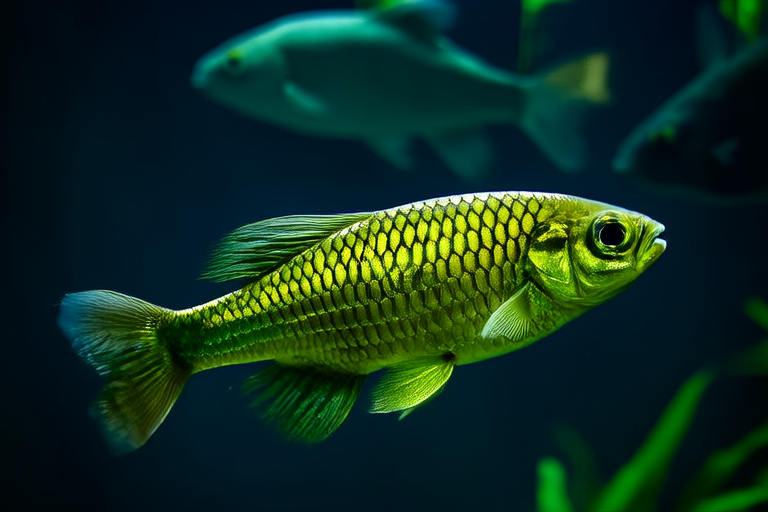Unlocking the Mystique: All You Need to Know About Arowana Care
Arowanas are among the most fascinating fish species cherished by aquarists worldwide. Known for their striking appearance and unique behaviors, these fish require specific care to thrive in captivity. This comprehensive guide will walk you through the ins and outs of arowana care, from setting up the perfect tank to addressing common health issues.
Optimal Tank Setup
The first step in arowana care is creating an environment that mimics their natural habitat. Arowanas are large, active fish that need ample space to swim freely. The recommended tank size for a single arowana is at least 300 gallons, with dimensions of about 7 feet long, 2 feet wide, and 2 feet deep. For multiple arowanas, the tank size should be increased proportionally.
Substrate choice is crucial. Gravel or sand can be used, but avoid sharp-edged substrates that might harm the arowana’s sensitive barbels. Live plants can enhance the aesthetic appeal and provide hiding spots. However, ensure that the plants are sturdy enough to withstand the fish’s powerful movements. Floating plants like Amazon frogbit and water lettuce are ideal as they provide shade and mimic the fish’s natural environment.
Proper filtration is essential to maintain water quality. High-quality filters that can handle the tank’s volume are necessary. Additionally, consider installing a protein skimmer if your tank has saltwater. Regular water changes and adequate circulation are vital to prevent the buildup of toxins and maintain a healthy ecosystem.
Water Conditions
Arowanas prefer slightly acidic to neutral water conditions with a pH range of 6.5 to 7.5. The temperature should be maintained between 78°F and 84°F (25°C to 29°C). Water hardness should be kept within the range of 5 to 12 dGH. To achieve these parameters, regular testing and adjustments are necessary. Equip your tank with reliable thermometers and pH testers to monitor the conditions.
Water quality is paramount. Ammonia and nitrite levels should be undetectable, while nitrate levels should be kept below 20 ppm. Regular partial water changes and efficient biological filtration help maintain these standards. It’s advisable to perform weekly water changes of approximately 20% to 25% of the total volume.
Diet and Feeding Habits
Arowanas are carnivorous and primarily feed on live prey in the wild. In captivity, their diet should include a variety of high-protein foods. Suitable options include frozen or live feeder fish such as guppies, mollies, and minnows. Additionally, they enjoy crustaceans like shrimp and crickets. Some aquarists also supplement their diet with pellets designed for predatory fish.
Feeding frequency and portion control are critical. Feed your arowana two to three times a week, providing an amount they can consume within five minutes. Overfeeding can lead to obesity and health issues. It’s important to observe their feeding behavior and adjust the quantity accordingly. Avoid feeding them too frequently, as this can disrupt their digestive system.
Common Health Issues
Despite their robust nature, arowanas are susceptible to certain health problems. One of the most common issues is bacterial infections, often caused by poor water quality. Symptoms include lethargy, loss of appetite, and visible sores or lesions. Prompt treatment with appropriate antibiotics under veterinary supervision is necessary.
Fungal infections can also occur, particularly if the fish have open wounds. These infections manifest as white, cotton-like growths on the body. Antifungal medications are effective treatments, but it’s crucial to address the underlying cause to prevent recurrence. Parasitic infestations, such as Ichthyophthirius multifiliis (Ich), are another concern. Symptoms include rapid breathing, scratching against objects, and white spots on the skin. Medication targeting parasites is required.
Regular observation and early intervention are key to maintaining the health of your arowana. Keep an eye out for unusual behavior, physical changes, and signs of distress. Consult a veterinarian specializing in exotic fish for accurate diagnosis and treatment.
Tips for Maintaining a Healthy Environment
To ensure your arowana thrives, several practices can enhance its well-being:
- Provide Adequate Space: Ensure the tank is spacious enough for the arowana to swim comfortably. This reduces stress and promotes healthy activity.
- Maintain Clean Water: Regular water changes and efficient filtration systems are vital to maintaining optimal water quality.
- Monitor Water Parameters: Consistently check and adjust pH, temperature, and other water parameters to prevent health issues.
- Offer a Varied Diet: Provide a diverse diet rich in proteins and nutrients to support overall health and vitality.
- Minimize Stress: Avoid sudden changes in the tank environment and keep noise and vibrations to a minimum.
- Encourage Natural Behavior: Incorporate elements that encourage natural behaviors, such as floating plants and appropriate tank mates.
By following these guidelines, you can create a thriving environment for your arowana, ensuring it lives a long and healthy life. With dedication and attention to detail, you can unlock the full potential of these majestic creatures, enjoying the beauty and wonder they bring to your aquarium.
